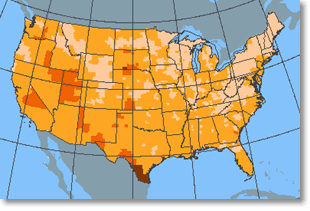Map Layer Info
| Reproductive Health: Live Births (Fertility), 1995-1999 | |
What this map layer shows: Live birth (fertility) rates report the number of women who had a live-born infant, per 1,000 women. |
 |
| Background Information | |
 Sample Map
Sample Map
Live birth (fertility) rates report the number of women who had a live-born infant, per 1,000 women. The National Atlas of the United States® prepared this map layer with information drawn from the Interactive Atlas of Reproductive Health. The Reproductive Health: Live Births (Fertility), 1995-1999 map layer reports statistics for thirteen demographic groups: mother's age 10-14, mother's age 10-19, mother's age 15-17, mother's age 18-19, mother's age 20-29, mother's age 30-39, mother's age 40-54, American Indian or Alaska Native, Asian or Pacific Islander, Black or African American, White, Hispanic or Latino, and all groups combined. The data set consists of three database files that are distributed together, one with county statistics, one with State statistics, and one with national statistics. The national statistics were calculated from data for the fifty States, the District of Columbia and five U.S. dependent areas (American Samoa, Guam, Northern Mariana Islands, Puerto Rico and the U.S. Virgin Islands.) In the National Atlas, additional reproductive health data sets are available that provide statistics on fetal and infant mortality, multiple births, preterm delivery, and maternal risks from smoking. Further general information on reproductive health is available from the CDC's Reproductive Health Information Source. |
|
| People |
| Map Maker Sample |
| Health - Live Births (Fertility) 1995-1999: All Groups |
| Data Download |
| Reproductive Health: Live Births (Fertility), 1995-1999 |
